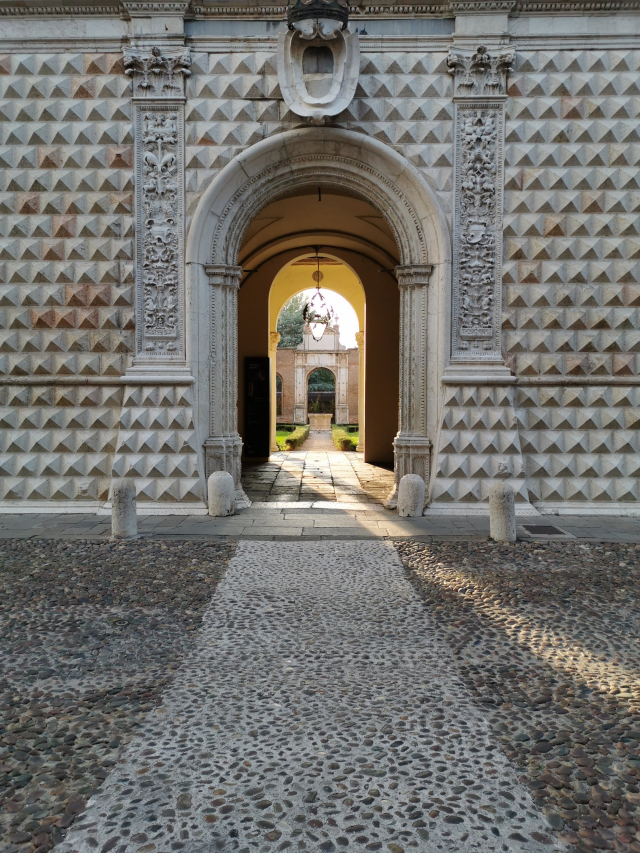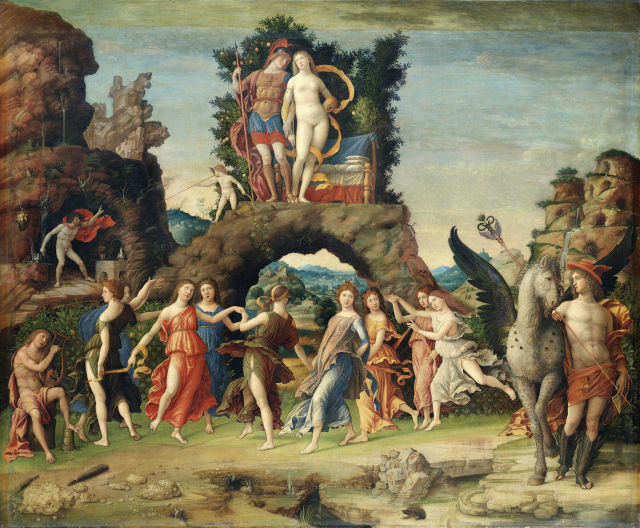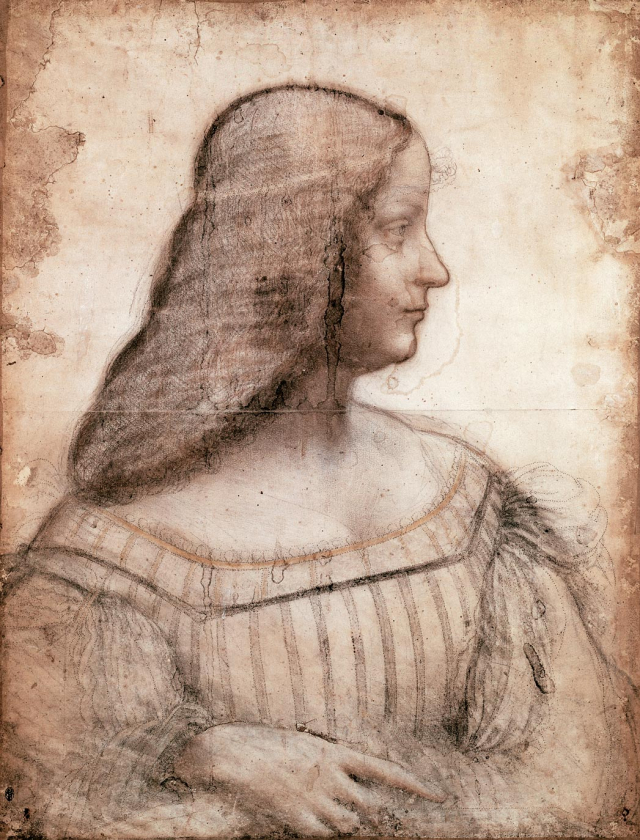Isabella d’Este, an exclusive interview
As all great art collectors in the Renaissance, also Isabella d’Este was mainly buying contemporary art, but with a deep interest in the old Greek and Roman masters.
Isabella d’Este was the most important Italian female art collector of her time, and one of the few women who had at her disposal enough cultural, economical and political resources to assert herself in a male dominated society. Isabella d’Este loved to design her own clothes and to compose perfumes, she was able to dance and play the lute. She was also taught disciplines considered more scholarly; she was given lessons of Greek, Latin and astronomy. She became very fond of ancient art, which however didn’t prevent her to love and support art of her own time as well. Thus she shaped her personality which thanks to the arts – and to the copious correspondence of letters that she left behind, has remained over the centuries extraordinarily vivid. This is why, rather than writing about her, we preferred to imagine her voice.
Historians regard Isabella d’Este as the most important female collector of the Renaissance, the only one in a male-dominated world. Where does your love for art come from?
Isabella d’Este: My family, in Ferrara, has always been close to musicians and architects, like Johannes Martini or Biagio Rossetti, who has worked a lot for my father Ercole and who was commissioned by my uncle Sigismondo to design Palazzo dei Diamanti. However, I believe that it was my mother Eleonora d’Aragona who played a crucial role in my educational development. She was the one choosing my tutors, amongst which Jacopo Gallino and Battista Guarini, the youngest son of the humanist Guarino Veronese, who was one of the few scholars to know Greek at that time. Thus I owe it to my mother if besides music, elocution and dancing, I was also able to enhance Greek and Latin culture. I think that fate offered me extraordinary opportunities. It was just a matter of seizing them.

Palazzo dei Diamanti’s main entrance, Ferrara, 2019. Ph. Stefano Pirovano.
On a political level, only few women had a similar role to yours.
Isabella d’Este: My husband was a Condottiero and didn’t spend much time in Mantua. I had to reign in his place when he was imprisoned by the Venetians between 1509 and 1510. I had to make important choices for our State. And when Francesco died from syphilis, I was appointed Marchess regent of Mantua and stayed in charge until my son Federico II reached the age of adulthood. Venice, Milan, Florence, Rome. In that troubled scenario little room for errors was left.
Did you collect for yourself or for the court of Mantua?
Isabella d’Este: I was a public figure, and I can’t deny that I tried, in my own way, to assert myself. When I moved to Mantua, the Gonzaga family was the commissioner of an exceptional artist like Andrea Mantegna, who was already working on the Triumphs of Caesar, a series of 9, actually 10 paintings to celebrate the feats of my husband. Thus, I felt a great sense of responsibility. I used to design my own cloths and I enjoyed creating perfumes and essences. Ultimately, I knew I had to play a part in it, too. I dedicated a lot of time and energy to the studiolo and the ‘grotta’, which could indeed be seen as a way to upgrade my role into a male-dominated world. The same goes for the many portraits I commissioned. However, I don’t think I acted simply to satisfy my ego. For a long time Isabella d’Este has represented the court of Mantua, and attracting talents such as Perugino, Raffaello, Leonardo da Vinci, depended to a large extent on my reputation as a patron. Again, I found myself in a society where too often the economic and media power was in the hands of ruthless men. I still remember when Francesco once said: “Abbiamo vergogna di avere per nostra sorte una moglie che vuol sempre fare di suo cervello” (I am ashamed of having as a spouse a woman who wants to do things only according to her own mind). I took it as a compliment.
Why did you ask Titian to re-paint the first portrait he made of you in 1529?
Isabella d’Este: Two years earlier I was in Rome, during the Sack by the imperial troops of Charles V. I barricaded myself into our family palace, in Piazza Santi Apostoli, and offered refuge to as many people I could – including the Ambassador of Venice. I was forced to buy weapons and gunpowder, and had a protective bulwark to be built. It was a very tough experience, also because my son Ferrante was actually enlisted in the invading army. In the end, I had to pay 40,000 ducats for our safety, which was a fortune if I think that the work Perugino made for my studiolo costed just 100. At that time not only I tried to save people, but also to redeem objects of art. I only partially succeeded. As you may know, the ship that had to take the works to Mantua, amongst which there were some of the cartoons Raphael produced for the Sistine Chapel tapestries, were seized by Turkish pirates. I think that the first portrait Vecellio painted bore the marks of this terrible experience. And of my old age too. I didn’t want to be remembered that way. Thus, I asked him to portrait me as I looked twenty years earlier, when I governed the destiny of Mantua for the first time, when my husband was imprisoned by the Venetians. This is the image of me that I wanted to pass on to future generations.
- Tiziano Vecellio, Ritratto di Isabella d’Este, c. 1534-36. Courtesy of Kunsthistorisches Museum, Vienna.
- Peter Paul Rubens, copia del ritratto di Isabella d’Este dipinto da Tiziano in 1529. Courtesy of Kunsthistorisches Museum Wien.
You also asked Leonardo to paint a portrait of you.
Isabella d’Este: That’s right. However, I never managed to have it. He drew a preparatory sketch but he then possibly gave the cartoon to one of his pupils. Apparently Leonardo thought the result wouldn’t really meet my expectations.
Could you tell us a bit more about your studiolo?
Isabella d’Este: I’ve always been fascinated by the Studiolo which was created by my uncle Lionello d’Este in the castle of Belfiore, and I was aware of the Studiolo of the Duke of Urbino. So, when I moved to Mantua, I thought about creating something similar. I needed a private and cosy space where to write and study. I was trying to set a dialogue between classicism which I loved so much and contemporary artists such as Andrea Mantegna, Perugino, Lorenzo Costa, or Giovanni Bellini. Their works had to represent my ideal world, the one I wanted for me and for Mantua. I asked Mantegna to paint Parnassus and Minerva Expelling the Vices from the Garden of Virtue; I entrusted the Combat of Love and Chastity to Perugino; while I asked Costa to paint me in the world of Harmony. Directly below the studiolo there was a vaulted ground-floor room where I kept those few antiques that I managed to gather together.

Andrea Mantegna, The Parnassus, 1496-1497. Detail.

Andrea Mantegna, The Parnassus, 1496-1497. Courtesy of Louvre Museum, Paris.
What about Giovanni Bellini?
Isabella d’Este: In the end Bellini declined my invitation as he said that my instructions were too detailed. I can see this was possibly a limit but it is also a matter of fact that the result of having specific requests such as asking for similar formats, with the same lighting effect, was going to be unique. This very same research for homogeneity was also the reason why I wasn’t completely satisfied with Perugino’s work which I would have preferred to be painted with oil instead of tempera.
With regards to the Alabaster heads plundered from the rubble of Palazzo Bentivoglio in Bologna that you nevertheless decided to acquire, what is your reply to those who consider your behaviour inappropriate, not to say unscrupulous?
Isabella d’Este: Well, I would say that, as Bruce Chatwin will have noticed five centuries later, unfortunately wars and natural disasters actually represent the best opportunities for collectors. If I hadn’t bought those heads, I am sure someone else would have done it, maybe a rival court, and maybe not so interested in antiques. The same goes for the bust of the roman empress Faustina that I bought from Mantegna. After all, better in Mantua than elsewhere. (Here’s the link to our analysis of Utz, by Bruce Chatwin, the novel to which Isabella d’Este refers).
You didn’t even return the Cupid by Michelangelo to Urbino when the Montefeltro reconquered the dukedom.
Isabella d’Este: Exactly. I got it from Cesare Borgia who deposed the Montefeltro. I didn’t see any reason why I should have returned it. Moreover, I already owned a similar statute, attributed to Praxiteles. The dialogue between the two objects embodied the quintessence of my vision, which from what I understood is also yours, isn’t it?
Correct. Any regret?
Isabella d’Este: Yes, one. Preferring Perugino over Botticelli.

Leonardo da Vinci, Portrait of Isabella d’Este, 1499-1500. Paris, Musée du Louvre, dép. des Arts graphiques, MI 753 © RMN.
May 12, 2021


